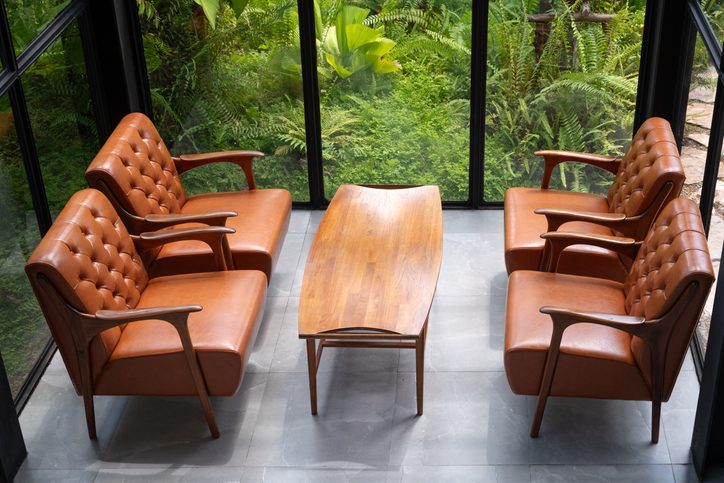Although trends seem to come and go less quickly than they did in the status-obsessed 1980s, they still swing around.
Lately, I heard I need to swap my skinny jeans for straight cuts or wide-legs (again). Red dining rooms or living rooms were all the rage in the early aughts, to be quickly replaced with all-white interiors for years, swinging back to earthy and jewel tones since 2020.
A quote attributed to French fashion designer Yves Saint Laurent says fashion fades, but style is eternal. That’s what the latest trend in home design — quiet luxury — is all about. Its hallmarks are classic, understated, well-crafted and timeless.
What Is Quiet Luxury?

The term has existed for decades, if not longer, although to this point it’s mostly been used in the fashion world.
I noticed an uptick recently in the mainstream pop-culture discourse with HBO’s wildly popular prime-time soap, Succession. The hour-long dramedy featured ultra-wealthy media conglomerate owners warring in Loro Piana cashmere, among other luxurious brands. A quick Google search reveals a basic Loro Piana cream crew-neck women’s cashmere sweater retails for $1,800.
The show’s fans had to do some digging, because there was nary a label or logo in sight. Label or not, the understated, elegant luxury was impossible to miss — the perfect cuts, the just-so silhouettes, the simplicity conferred an unmistakably elite air. That’s when, as a design writer myself, I know design isn’t just good. It’s gooooood good.
As Susan Serra, president and designer at Susan Serra Associates, Inc. says, you’re moving from “obvious representations of wealth” to “products that are more visually ‘quiet,’ allowing the form, material, fabric, etc. to quietly tell the story of quality. If you know, you know — and all that.”
Artem Kropovinsky, an interior designer and founder of Arsight, embraced quiet luxury for what it is — and isn’t.
“Instead of screaming affluence, it whispered elegance,” he says. “Over time, this philosophy expanded, finding its rightful place in interior design. In home decor, it’s about creating a space that exudes understated opulence, sophistication without the shout, and beauty in subtlety.”
Why Is Quiet Luxury Popular Now?
“Beyond its adaptability and comfort, this aesthetic resonates because of its timelessness,” says Kropovinsky. “It’s an investment in eternity, not a fleeting romance with transient trends.”
This appeals those with giant budgets to spend on interior design, as well as thrifty types who make what they have last. By investing in classic, quality-made pieces (and not necessarily paying an upcharge for a logo), you’re investing in daily luxury that looks and feels good.
Mariya Snisar, head of interior design at Renowell, says she feels several societal shifts and changing consumer attitudes led to the popularity of quiet luxury.
“Many people desire a more considered, meaningful and intentional way of living,” she says. “The style offers a respite from the noise and haste of modern life, inviting individuals to surround themselves with items and environments that bring them comfort, pleasure and a sense of enduring value.”
This includes valuing quality over quantity, escaping over-stimulation from the digital world, and focusing on sustainability and an appreciation for timelessness.
How To Get the Quiet Luxury Aesthetic

Start by understanding the overarching philosophy, then develop your personal style within it.
“Quiet Luxury is primarily characterized by minimalism,” says Robbie Maynard, principal and interior designer at Robbie Maynard Interiors. “It’s a sharp contrast to more flamboyant styles from early 2020.
“With clothing, the concept is to invest in a few high-quality timeless pieces. It’s the same with home furnishings. Select some key pieces and spend more on these items. Splurge on a special sofa, piece of art or gorgeous rug and then build from there with more affordable pieces like lamps, pillows and side tables to complete your individual story.”
For home, consider the same categories you always do in selecting pieces: material, texture, color, contrast, etc. Then buy the best you can for your budget.
Some examples:
Bedroom
Here, maybe you invest in quality linen bedding, or something with a high thread count.
Living room
Maybe you choose a stunning workhorse like an Eames recliner, which becomes the showpiece of a lifetime without showing off.
Kitchen
Serra sees swapping busy textures, like live-edge wood tables or busy tile backsplashes, for hidden or near-invisible hoods, more performance-focused or sustainable products or built-in, clean-lined appliances. Maybe with cabinet fronts!
“Crafting a quiet luxury ambiance begins with muted undertones,” Kropovinsky says. “Delve into palettes that whisper rather than shout. Think creams, beiges and soft grays.
“But a room’s spirit doesn’t just reside in colors. It’s in the craftsmanship, the grains of wood, the cool touch of stone, or the sheen of metal. Quality isn’t an extravagance — it’s a necessity.”
Other designers say layering paints to make a more luminous, complex color, or using jewel tones and darker colors, can confer the same feeling.
The Last Word
Remember, quiet luxury is about fewer things of higher quality, so keep scale in mind. Perhaps replace a bunch of smaller decorative objects with a few larger pieces.
“Minimalism is often misconstrued as emptiness,” Kropovinsky says. “But in the realm of quiet luxury, it’s about celebrating each piece, granting it the space to narrate its tale.”
Did you miss our previous article...
https://rsssuperfeeds.com/life-hacks/8-tips-for-dealing-with-a-flat-tire-quickly






